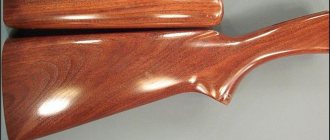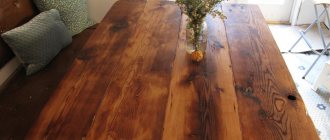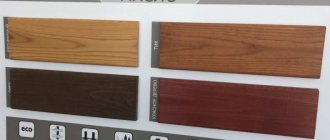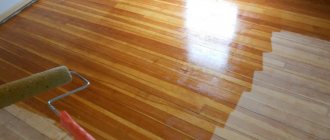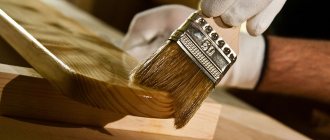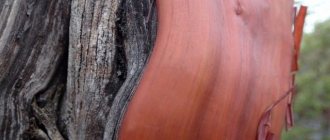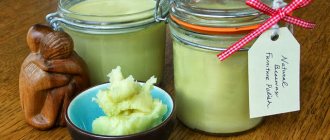Using oil and wax to treat wood
Natural wood has many advantages, but it also has disadvantages. This is a high sensitivity to a humid environment. When exposed to liquid, untreated wood fibers begin to swell and become deformed, and with long-term exposure, rotting begins.
How can I avoid this? To do this, use oil-wax for exterior woodwork. Here we are talking about a composition that is sold ready-made or made with your own hands.
The second option is preferable for those who are not afraid of experiments and want to try different methods of processing wood surfaces.
Advantages of oil-wax for wood
Previously, only yacht varnish composition was used for this, which perfectly protects the wood from the negative effects of moisture. The composition can make the color of the wood rich and beautiful, and the fiber structure – clearly expressed. But varnish also has its downsides. It wears out and cracks, which is why it needs to be constantly updated (once every 5 years, it all depends on the intensity of use). Removing the old layer is a difficult process, and applying a new coating will be associated with enormous difficulties. The varnish is toxic, and therefore you should take precautions.
Compared to it, oil-wax has many advantages:
- Easy to apply - even hand-made compositions can be easily washed into the surface of natural wood.
- Penetration depth - the paint and varnish composition remains on the surface of wood products, while the oil-wax will penetrate very deeply into the fiber structure and provide reliable protection.
- Practicality - when applied correctly, such compounds provide excellent protection against sudden temperature changes, mold and humidity.
- Vapor permeability - if the varnish completely clogs the pores and various types of holes, then the oil-wax will preserve them. The wood will “breathe”, which will lead to natural ventilation and prevent the process of rotting.
- Non-toxic - such compositions contain a number of caustic components, which is why you should be extremely careful when working with it. But most often, oil-wax is made from ingredients of natural origin, safe and non-toxic to human health.
If previously, when replacing floorboards, it was necessary to remove the entire paint layer and reapply it, now you can avoid all this. You simply lay a new board and treat it with the same composition that was used for the floor treatment. This will ensure uniformity of the coating structure as a whole. When applying wax, the wood fibers will remain free and not constrained. If the floorboards are laid on a heated floor system, then during temperature changes, cracks will not appear on the wooden surface, since it can increase and contract in volume without deforming.
What problems does wax solve in combination with oil?
Wax-based oil is suitable for treating the facades and external walls of log houses, protecting plank floors, wooden furniture, parquet and parquet boards. The hard wax in the composition creates an abrasion-resistant coating, so it is preferable to use it for floors and doors. Products based on liquid wax are good for finishing facades, terraces, balconies, and wooden stairs.
Wax in protective oil performs several functions:
- Prevents moisture from penetrating into the fibers, cracking and drying out of wood.
- Protects it from fungus and mold.
- Increases the wear resistance of the material, water and dirt repellent properties.
- Gives the surface a decorative appearance.
- When applied externally, it additionally protects against ultraviolet radiation and precipitation.
Wax-based oil is often used for underfloor heating. Wood that is regularly heated and cooled changes its geometric dimensions. The varnish coating, under conditions of regular expansion and contraction, quickly cracks, which cannot be said about the plastic wax composition.
Wax-based oil protects the wooden frame from ultraviolet radiation and precipitation
Using oil and wax on wood
How to choose oil-wax
The main criterion is the composition of the product, which specific components are included in it. The final result and tone of the wood will directly depend on this. The product is made of beeswax, oil (jojoba, olive or linseed), color (they saturate the color) and a solvent, which makes the product not so thick (the smaller its mass fraction, the faster hardening will occur).
If you purchase a ready-made product, you should make sure that the composition does not contain aggressive solvents or benzene. It is worth taking into account the type of wood, since even the absorption rate and consumption of the composition will directly depend on this. There are compositions on sale for soft, deciduous and even exotic wood species.
Oil-wax impregnation often contains components that will make the surface shiny and glossy. It looks quite impressive, and this product is also suitable for interior work. But it is important to be very careful, since when treated with this product the coating becomes slippery.
Production methods: 8 proven recipes
And now it’s time to talk about exactly how to prepare oil-wax yourself and what ingredients are needed for this. For maximum convenience, we will present the ratio of components. It is worth following this recommendation and this way you can prepare a high-quality product for treating wood flooring.
Rosin + wax + turpentine
This composition is perfect for processing pieces of furniture, as it will make it possible to create a special protective film, due to which dust will not harm wood surfaces in any way, and a characteristic coating will not appear on top. This was made possible by the addition of turpentine. It will make the composition not so thick, which will simplify application and make it possible to work with the surface as much as required. The proportions are 4 measures of beeswax, 2 measures of turpentine and 1 measure of rosin. Please note that you should melt the wax and make it liquid, and then add crushed rosin. The components should be combined and then wait for complete dissolution. Next, pour in turpentine and stir.
Rosin + gasoline + paraffin
This composition is suitable for outdoor work, and if you have a wooden terrace, bench, gazebo and canopy, it will protect them from the aggressive influence of external factors. The product contains gasoline, and therefore it can only be used in places where there are no special requirements for environmental friendliness.
The proportion is 55% paraffin, 40% refined gasoline and only 5% crushed rosin.
It is possible to replace gasoline with simple purified acetone, and it is also much more expensive, but it dissipates more quickly and does not leave a smell. When creating the product, you should take precautions, and even more so when melting paraffin. It is worth keeping the container with gasoline as far as possible from the fire. This composition is best prepared in an open space, which helps to avoid concentration of vapors. If this is not possible, and you have to mix components, then it is worth considering the features of ventilation of the room.
Linseed oil + wax + rosin + turpentine
Quite a popular product that is used when processing wood products. These are dishes, small pieces of furniture, various wooden counterfeits, etc. This will affect the huge consumption of materials, which is associated with large expenses. Proportions - from 25 to 30% beeswax, from 35 to 40% purified linseed oil, 5% rosin and from 20 to 30% turpentine. If you don’t have flaxseed oil or it’s too expensive, you can replace it with sunflower or olive oil. Make sure it is clean or free of impurities/sediment as this will only degrade the quality of the treatment. All components are mixed with each other and heated, and then the product will be ready.
Propolis + linseed oil + wax
Interestingly, propolis is used not just for cosmetic and medicinal purposes. Its composition is able to enrich the wood, making it strong and “alive”. Propolis is known for its adhesion to wax and penetrating properties, and therefore the mixture is of very high quality. The proportions are as follows - 4 measures of linseed oil, 2 measures of propolis and 1 measure of beeswax. The disadvantage of this product is the high price, which is due to the cost of propolis itself. If you do decide to prepare it, you should make sure that the flaxseed oil is purified, otherwise excess impurities will appear in the oil-wax. The cooking technology is clear and simple. Propolis and wax are melted, and then oil is poured into them and the mixture is thoroughly mixed. This product is suitable if you are making utensils from wood.
Lard + linseed oil + Sunday
How to use wood oil in combination with lard? Melted lard (pork) is perfect for processing natural wood. This is due to the increased degree of fat content, which creates a special protective film. In its pure form, no one will rub wood floors or utensils with fat, since it is used as one of the components. Proportions – 3-4 measures of beeswax, 10 measures of linseed oil and 1 measure of lard. Mixtures based on rendered lard or even propolis have almost the same effect, but with lard it turns out much cheaper. In each case, it is worth applying the composition at least 2 times, when 1 layer dries well. This will make it possible to achieve the desired result.
Uses of olive oil
This is another quite popular and yet easy-to-make recipe that is useful when working with wood. To do this you need 7 measures of olive oil and 2 measures of beeswax. It is worth taking the wax and crumbling it as best as possible, and then knead everything until a homogeneous mass is obtained. Then mix it with olive oil and let it brew in a water bath. You need to melt the mixture, and then remove it from the heat and mix until it is homogeneous. This composition should be stored in a glass container with a lid, since upon contact with air it will harden and lose its qualities.
Wax based on jojoba oil
If you find this excellent oil on sale, you can consider yourself lucky. It has excellent properties that are healing for the tree. A mixture based on such oil will protect the fibers from the process of deformation and will not allow them to swell. Proportions – 3 measures of pressed jojoba oil and 1 measure of beeswax. In the process of preparing the composition, it is worth following the proportions, which helps to achieve optimal consistency and preserve the natural properties of the oil.
The components need to be melted in a water bath and mixed thoroughly. The composition is stored in a glass jar for up to 2 years, and at the same time it will not lose its original properties. For this reason, you can regularly use it when renewing and strengthening wood flooring.
Carnauba wax for wood processing
The last recipe (but definitely not the least important) will interest you. Carnauba wax is currently on sale. It has miraculous properties and ideally reflects on the condition of the tree - it strengthens it, makes the fibers strong and resistant to moisture. The big difficulty in creating a product based on carnauba wax is that it melts at high temperatures, and therefore is mostly used to create mastic at home. For cooking you need:
- Place carnauba wax flakes in a metal container, cover with a lid and heat over low heat.
- Add oil (hemp or flaxseed) in a 2 to 1 ratio (2 measures of oil and 1 measure of wax).
- Heat the mixture until it melts.
- Stir as best as possible.
- Pour into a glass container.
During long-term storage, this mastic will harden. So, you will have to heat it again to a liquid state and add a little purified oil, and then you can apply it to the surface of the wood.
Application technology
Each manufacturer's use is indicated on the label. But there are standard methods:
- Immersion - when a wooden element is immersed in a hot composition and left to soak for several days. Then it is taken out and dried on a warm surface.
- Vacuum impregnation - the product is placed in a special device, where, under the influence of a vacuum, the oil penetrates deep into the wood.
- Two-layer application - performed using a brush or a piece of foam rubber when finishing the premises.
Let's take a closer look at two-layer application, which is suitable for treating wooden floors, stairs and walls.
Application technique
So how do you apply wax to wood? First you should clean the product. There should be no dust, small debris, dirt or paint on it. The same can be said for grease stains. Apply the mixture with a brush, and also make sure that the bristles do not fluff and do not leave lint on the surface.
Oil-wax is applied in a thin layer over the overall coating of the product, and it is important to avoid the appearance of seams and sagging. The surface should be smooth and uniform. Thick formulations often leave excess on the bristles of the brush, which quickly hardens. This is how clots appear. If you notice this, it is important to regularly wipe your brush and remove any lumps.
After applying the first layer, you should let it dry. It's better to take your time and be patient. If you do not wait the required amount of time and start checking the wax, fingerprints will remain on the surface. This procedure should be performed 2-3 times, since the wooden surface can be saturated with oil and wax, and the ingredients will get into small, hard-to-reach cracks, thereby filling them and protecting them from moisture. Polishing the wood surface can be done with a simple cotton cloth. If you have a sanding machine at home, you should use it, but you should avoid abrasive materials and discs, as they damage the wood surface and leave characteristic abrasions and marks on it. The processing procedure is simple. With practice, you'll be able to apply the product to woodwork like a pro.
Hard waxes
Solid wood wax for interior work of plant origin is extracted from the leaves of the Brazilian wax palm, or carnauba. Carnauba wax is the most refractory and hard, its melting point is 91°C. That is why it is so popular and widely used in the shipbuilding and automotive industries, as the basis of a protective coating. In addition, solid carnauba wax is absolutely safe, hypoallergenic and non-toxic, which allows it to be used even in food products.
Hard wax extracted from the candelilla bush also has hypoallergenic properties, is safe for humans and is widely used in cosmetics, registered as a food additive. It has a high melting point of 72°C and is an excellent alternative to beeswax.
Hard wax nourishes the wood, gives it a soft shine, and protects the wood from wear and fading. A surface coated with protective oil and hard wax acquires dirt- and water-repellent properties. The oil and wax mixture for interior work is safe, versatile and can be used on any surface.
Wood wax oil for interior work is more often used for high traffic areas to protect the surface from abrasion and mechanical damage. Oil impregnation penetrates deep into the inner layers of wood, and wax forms a coating that is resistant to external influences. At the same time, the wood “breathes” and remains tactilely pleasant.
Impregnation of wood at home
You can also do wood impregnation yourself. To make such a mixture and apply it to wood, you will need the following tools:
- Oil and wax.
- Brush.
- Kitchen grater.
- Glass jar.
- Any heating element (for example, a gas stove).
- Large bowl (for heating wax and oil)
- Foam sponge and soft cloth (to remove excess moisture-resistant impregnation).
- Wooden or metal stick (for stirring the hydrophobic impregnation during heating).
- A wire brush, spatula, heat gun, sandpaper or any other available wood processing tools.
